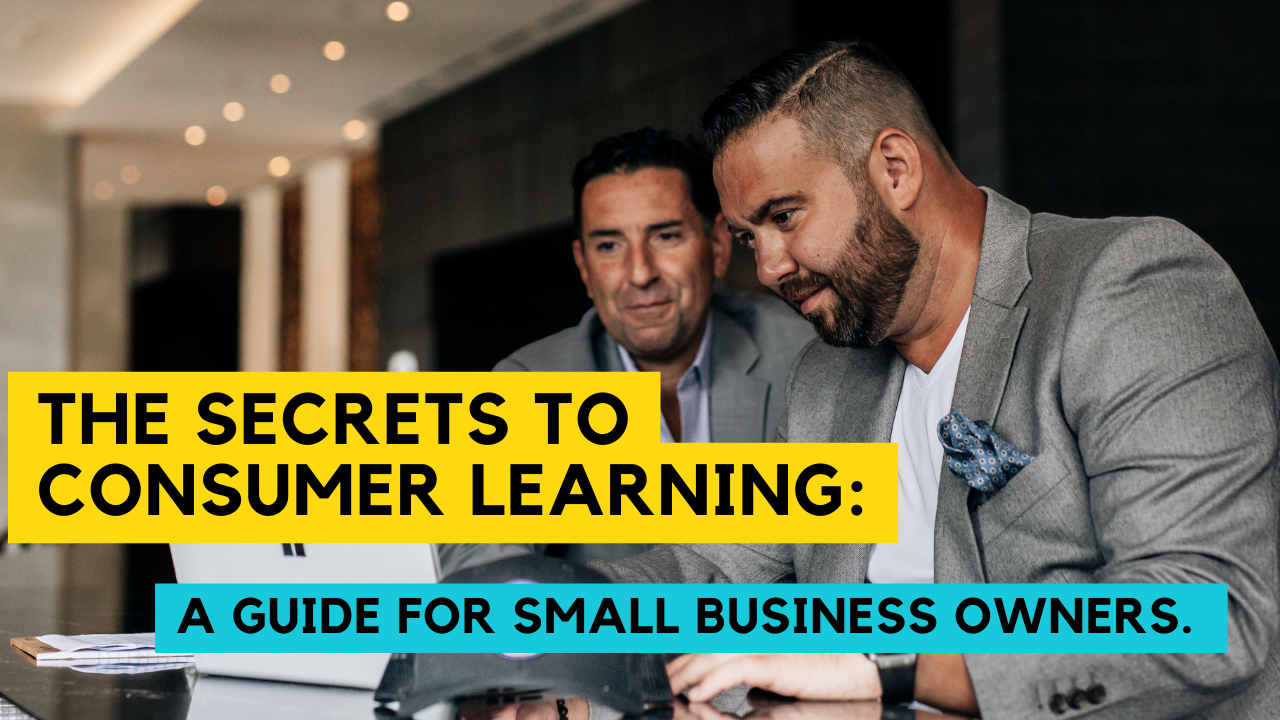Unveiling the Secrets of Consumer Learning: A Guide for Small Business Owners

In the ever-evolving world of consumer behavior, small business owners face a continuous challenge in understanding how consumers want to learn about products. In fact, research shows that almost 90% of consumers view the experience the company provides as JUST AS important as the product or service they’re selling. That’s huge.
To thrive in a competitive market, it is vital for businesses to adapt and cater to the changing preferences of consumers. Here’s a look at some specific examples of how consumer learning has transformed, along with some actionable tips for small business owners to effectively promote their products or services with the customer experience in mind.
Embrace the Power of Digital Platforms:
This first point is hardly surprising (but still worth addressing), and that is the significant shift in consumer behavior towards digital platforms. Consumers now turn to websites, social media, online reviews, and search engines to gather product information. (RIP Yellow Pages and newspaper ads.) To effectively reach your target audience, you must establish a strong online presence through a well-designed website and active engagement on social media platforms. Our advice:
- Optimize your website: Ensure your website is user-friendly, mobile-responsive, and optimized for search engines. Make it easy for consumers to find product information and place orders.
- Leverage social media: Remember, not all platforms are created equal. You should identify which ones your target audience is most active on and create engaging content that showcases your products. Encourage user-generated content and engage in meaningful conversations with your customers.
Harness the Power of Visual Content:
Visual content has become increasingly influential in consumer learning. People don’t just want to be TOLD what the product or service can do…they want an explanation and to see it in action. Images, videos, and infographics can all help them understand products better. As a small business owner, focus on creating visually appealing content that highlights the features and benefits of your products. Our advice:
- High-quality product imagery: Invest in professional product photography to create visually captivating images that showcase your products in the best possible light. Photoshopping shitty images will only give you less-shitty images. Quality matters.
- Explainer videos: Create short and informative videos demonstrating how your products work or providing solutions to common problems. These videos can be shared on your website, social media platforms, or even in email marketing campaigns.
Leverage Influencer Marketing:
Yes, the term “influencer” makes us cringe a little bit. Still, the fact remains that influencer marketing has gained tremendous popularity in recent years as consumers trust recommendations from individuals they admire. Identify influencers relevant to your industry or niche and collaborate with them to promote your products. This strategy can help you reach a wider audience and build trust with potential customers. Our advice:
- Research and vet influencers: Look for influencers who align with your brand values and have an engaged and authentic following. Micro-influencers with a smaller but highly targeted audience can be particularly effective. Keep in mind that even though they aren’t an “employee” of your company, their online persona will be associated with your brand, for better or worse, so vet accordingly.
- Offer value to influencers: Provide influencers with a unique experience or exclusive access to your products. This can enhance their enthusiasm and result in more authentic and impactful content.
Personalization and Customer Interaction:
Consumers today expect personalized experiences and value authentic interactions with brands. (There’s a reason Wendy’s Twitter account has 3.8 M followers, and spoiler alert: it’s not because of their burgers.) Small business owners can capitalize on this trend by incorporating personalization, fostering customer engagement, and just having a bit of fun. Consider the following strategies:
- Customized recommendations: Utilize customer data to provide personalized product recommendations based on past purchases or browsing history. This can be implemented through AI-powered recommendation engines or personalized email marketing campaigns.
- Encourage user reviews and testimonials: Actively seek and showcase positive reviews and testimonials from satisfied customers. This social proof can significantly influence potential buyers.
Measure, Analyze, and Adapt:
Lastly, small business owners need to measure the effectiveness of their marketing efforts, analyze consumer responses, and adapt their strategies accordingly. You probably won’t strike oil on your first try. Utilize analytics tools and customer feedback to gain insights into what works and what doesn't. Consider the following actions:
- Track website analytics: Monitor website traffic, conversion rates, and user engagement metrics to identify areas for improvement and optimize your online presence.
- Listen to customer feedback: Encourage customers to provide feedback through surveys, social media, or customer support channels. Actively listen to their suggestions and concerns, and use this information to enhance your products or services.
As small business owners, we must (to an extent) bend and adapt to the will of the customer, stay attuned to evolving consumer preferences, and adjust our strategies accordingly. By embracing digital platforms, leveraging visual content, harnessing influencer marketing, personalizing experiences, and continuously measuring and analyzing results, small businesses can effectively reach their target audience and build lasting relationships with customers. Remember, staying agile, responsive, and customer-centric is the key to success in today's ever-changing consumer learning environment.



